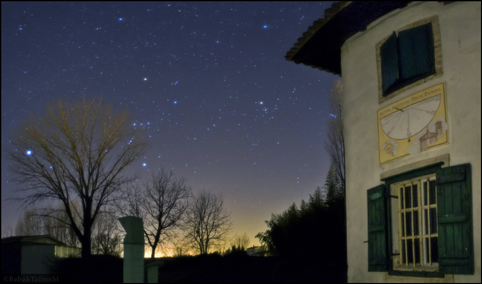Places connected to the Sky
village of sundials with an ever growing number of beautiful and artwork sundials.
Copyright: Babak Tafreshi/Dreamview.net

 As an IAU100 Endorsed Project Pc2S provides extra means to achieve the IAU100 main goals and objectives. It aims to raise awareness that astronomy represents a rich and significant aspect of cultural and natural heritage. It encourages the general public worldwide to engage with their local astronomy-related places and to present them alongside many others in this global collection which is separate from the case studies that form the main content of the portal, but is also searchable using our Astronomical Heritage Finder.
As an IAU100 Endorsed Project Pc2S provides extra means to achieve the IAU100 main goals and objectives. It aims to raise awareness that astronomy represents a rich and significant aspect of cultural and natural heritage. It encourages the general public worldwide to engage with their local astronomy-related places and to present them alongside many others in this global collection which is separate from the case studies that form the main content of the portal, but is also searchable using our Astronomical Heritage Finder.Locations on our planet can be connected to the sky in diverse ways, as places like Aiello del Friuli, village of sundials and Otford solar system show very well. PC2S gives anyone the opportunity to suggest and submit places such as this for inclusion on the Portal alongside the main case studies.
 During 2021, with so much less opportunity to travel and visit interesting places, we are interested more than ever in your suggestions of places we can include on our PC2S list, so that they can be explored on-line, here on the Portal. Because of this we have joined forces with Astronomers without Borders who are encouraging their over twelve thousand members from 146 countries to contribute to this global register of Places connected to the Sky.
During 2021, with so much less opportunity to travel and visit interesting places, we are interested more than ever in your suggestions of places we can include on our PC2S list, so that they can be explored on-line, here on the Portal. Because of this we have joined forces with Astronomers without Borders who are encouraging their over twelve thousand members from 146 countries to contribute to this global register of Places connected to the Sky.
See Prof. Ruggles´ presentation of the project as part of GAM-2021 of AstronomersWithoutBorders.
If you would like to submit a place yourself, please create a user account first. Once you are logged in, you can submit your proposal by filling out the form that you will find below the map. Please also review our general rules for these submissions. After an initial evaluation of your submission by our project team, we will ask you to provide more detailed information about your place and how it is connected to the sky. Once we have received and evaluated this information, we will proceed to publication.





